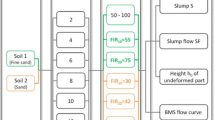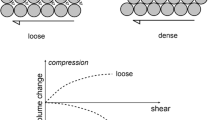Abstract
Due to the diverse and complex structure of soil and the variety of foam-modifier materials that are used, it is difficult to provide a model to predict the laboratory behavior of modified soils. For example, several studies have shown independently that the amount of the foam-modified soil depends on several factors, such as the internal friction angle and normal stiffness. Of late, modeling by numerical methods has become popular in engineering sciences and the modeling of complex material behavior is possible with the help of numerical methods. In this research, the performance and efficiency of the numerical method in the modeling of laboratory tests such as the slump test and the uniaxial compressive strength test were investigated and it was found that numerical modeling performs very well in predicting the results of these tests for foam-modified sand samples. In order to achieve this goal, the slump test and the uniaxial compressive strength test were performed in the laboratory on several modified sand samples in order to obtain the laboratory results for these samples. Then, numerical simulation of these experiments was carried out using PFC3D software. The results of numerical modeling were compared with the experimental results, and good agreement was observed. Finally, after calibration of the numerical model using the experimental results, the effect of changes in the internal friction angle and the normal stiffness of the modified sand in the amount of the slump was investigated. According to the results of this sensitivity analysis, it was determined that by increasing both effective parameters the amount of the slump of foam-modified sand decreases and that the parameters are the most important factors in controlling the slump value.







Similar content being viewed by others
References
Bezuijen A, Schaminee PEL, Kleinjan JA (1999) Additive testing for earth pressure balance shields. In: Proceedings of the 12th European conference on soil mechanics and geotechnical engineering, Amsterdam, pp 1991–1996
Cash T, Vine-Lott KM (1996) Foam as a tunneling aid: its production and use. Tunn Tunn 28(4):22–23
EFNARC (2001) Specification and guidelines for the use of specialist products for soft ground tunneling. In: European federation for specialist construction chemicals and concrete systems
Itasca Consulting Group, Inc. PFC3D (Particle Flow Code in 3 Dimensions), Version 4
Jancsecz S, Krause R, Langmaack L (1999) Advantages of soil conditioning in shield tunneling: experiences of LRTS Izmir. In: Allen et al. (eds) Proceedings of the conference challenges for the 21st century, Balkema, Rotterdam, pp 865–875
Kusakabe O, Nomoto T, Imamura S (1997) Geotechnical criteria for selecting mechanized tunnel system and DMM for tunneling. In: Panel discussion, proceedings of the 14th international conference on soil mechanics and foundation engineering, Hamburg, vol 4, pp 2439–2440
Langmaack L (2000) Advanced technology of soil conditioning in EPB shield tunneling. In: Proceedings of the North American Tunnelling, 00, Balkema, Rotterdam, pp 525–542
Leinala T, Delmar R, Collins JR, Pennington BN, Grabinsky M (1999) Soil conditioning for enhanced TBM performance in differing ground conditions. In: 52nd Canadian geotechnical conference, Regina, pp 537–544
Leinala T, Grabinsky M, Delmar R, Collins JR (2000) Effects of foam soil conditioning on EPBM performance, North American Tunneling 2000, Boston. In: Ozdemir (ed) Balkema, Rotterdam
Leinala T, Grabinsky M, Klein K (2002) A review of soil conditioning agents for EPBM tunneling. In: 17th Tunnelling Association of Canada Conference, Toronto
Maidl B, Herrenknecht M, Anheuser L (1996) Mechanized shield tunneling. Ernst and Sohn, Berlin
Milligan GWE (2000) Lubrication and soil conditioning in tunneling, pipe jacking and microtunnelling: a state-of-the-art-review. Pipe Jacking Research Group, http://wwwcivil.eng.ox.ac.uk
Milligan GWE (2001). Soil conditioning and lubricating agents in tunneling and pipe jacking. In: Proceedings of the underground construction 2001, London, pp 105–116
Quebaud S, Sibai M, Henry JP (1998) Use of chemical foam for improvements in drilling by earth-pressure balanced shields in granular soils. Tunn Undergr Space Technol 13(2):173–180
Shirlaw JN, Ong JCW, Osborne NH, Tan CG (2002) The relationship between face pressure and immediate settlement due to tunneling for the North East Line, Singapore. In: Proceedings of the geotechnical aspects of underground construction in soft ground, Toulouse, pp 3/25–30
Standard Test Methods for Laboratory Compaction Characteristics of Soil Using Standard Effort, ASTM D 698-78
Standard Test Method for Slump of Hydraulic Cement Concrete (1995) ASTM C143-90, vol 04.02
Steiner W (1996) Criteria for selecting mechanized tunneling systems in soft ground. In: Proceedings of the North American Tunnelling 96, Balkema, Rotterdam, pp 483–491
Wallis S (1990) Screw conveyors will take the pressure. In: Tunnels and tunnelling, pp 31–34
Williamson GE, Traylor MT, Higuchi M (1999) Soil conditioning for EPB shield tunneling on the South Bay Ocean Outfall. In: Proceedings of the rapid excavation and tunnelling conference, Colorado, pp 897–925
Author information
Authors and Affiliations
Corresponding author
Rights and permissions
About this article
Cite this article
Pourmand, S., Chakeri, H., Sharghi, M. et al. Investigation of Soil Conditioning Tests with Three-Dimensional Numerical Modeling. Geotech Geol Eng 36, 2869–2879 (2018). https://doi.org/10.1007/s10706-018-0509-8
Received:
Accepted:
Published:
Issue Date:
DOI: https://doi.org/10.1007/s10706-018-0509-8




